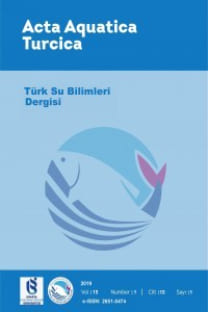Bazı Ticari Zenginleştiricilerin Artemia sp.’ nin Yağ Asidi Kompozisyonuna Etkileri
Bu çalışmada, deniz balıkları kuluçkahanelerinde yeşil su tekniğinde yoğun olarak kullanılan Nannochloropsis oculata ve ticari zenginleştiricilerin (Olio ω3, Redpepper), artemia’ nın yağ asitleri üzerine etkileri araştırılmıştır. Bu amaçla çalışmada, 6 deneme grubu 3 tekerrürlü olarak oluşturulmuştur; Redpepper, N.oculata, Olio ω3, Redpepper+N.oculata, Olio ω3+N.oculata ve kontrol grup. Artemia’ya zenginleştirme işlemi 24 saat için uygulanmıştır. Çalışma sonucunda, toplam yağ içeriğinin yüzdesi olarak, en yüksek DHA (% 8,03) oranı Redpepper ile zenginleştirilmiş artemia grubunda bulunurken, en yüksek EPA (%11,18) oranı Olio ω3+N.oculata ile zenginleştirilen artemia grubunda bulunmuştur. En düşük EPA ve DHA oranları kontrol ve N.oculata gruplarında tespit edilmiştir. Ayrıca en yüksek n3 HUFA ve PUFA değerleri, Olio ω3 içeriğine sahip artemia gruplarda tespit edilmiştir. Sonuç olarak, Olio ω3 ürününün 1/3 oranında azaltılarak alg ilavesi yapılmış grup EPA ve n-3 HUFA yağ asitleri açısından en iyi grup olmakla birlikte, DHA açısından da desteklenmesi gerekir.
Anahtar Kelimeler:
Artemia sp., zenginleştirme, Nannochloropsis oculata, redpepper, Olio ω3, yağ asitleri
Effects of Some Commercial Enrichment Products on Fatty Acid Composition of Artemia sp. Abstract
In this study, the effects of commercial enrichment products (Olio ω3, Redpepper) and Nannochloropsis oculata, extensively used in the green water techniques in marine fish hatcheries, on fatty acid composition of artemia were investigated. For this purpose, the following treatment groups were conducted in triplicate; Redpepper, N.oculata, Olio ω3, Redpepper+N.oculata, Olio ω3+N.oculata and un-enrichment control group. Artemia was applied enrichment for 24 hours in all treatments. At the end of this study, the highest DHA (% 8.03) content was found at enriched artemia group with Redpepper while the highest EPA (%11.18) content was found in enriched artemia group with Olio ω3+N.oculata. The lowest EPA and DHA contents were determineted in control and N.oculata groups. In addition, the highest n3 HUFA and PUFA contents were found at groups including Olio ω3 groups. As a result, although, Olio ω3+N.oculata group which is addition algal by reducing 1/3 of Olio ω3 is the best groups in terms of EPA and n-3 HUFA fatty acids, this group should be supported in terms of DHA.
Keywords:
Artemia sp., enrichment, Nannochloropsis oculata, redpepper, Olio ω3, fatty acids,
___
- AOAC, 1995. Official Methods of Analysis of AOAC International. 2 Vols. 16th Edition. Association of Analytical Communities Arlington, VA, USA.
- Basmaz, N., Aydın, İ., Koc, T., Kocakaya, S. 2003. Akdeniz Bolgesi İklim Koşullarında Artemia parthenogenetica’nın Toprak Havuzlarda Biyomas ve Kist Uretim Olanaklarının
- Araştırılması. TUBİTAK 199Y090 Nolu Projenin Sonuc Raporu, Ankara. Bligh, E.G., Dyer, W.J. 1959. A Rapid Method of Total Lipid Exraction and Purification. Can. J. Physiol. Pharmacol., 37: 911-917.
- Brown, M. R. 1991. The Amino Acid and Sugar Composition of Sixteen Species of Microalgae Used in Mariculture. J. Exp. Mar. Biol. Ecol., 145: 79-99.
- Coutteau, P., Sorgeloos, P. 1997. Manipulation of Dietary Lipids, Fatty Acids and Vitamins in Zooplankton Cultures. Freshwater Biol., 38: 501-512.
- Demir, O., Diken, G. 2011. Effects of Commercial Enrichment Products on Fatty Acid Components of Rotifer, Brachionus plicatilis. Afr. J. Biotechnol., 10(66): 15065-15071.
- Derarslan, D. 2012. Artemia franciscana’nın Yağ Asidi Kompozisyonunda Ticari Zenginleştirici Urunlerin Etkileri. Yuksek Lisans Tezi, Suleyman Demirel Universitesi, Isparta.
- Eymen, U.E. 2007. SPSS 15.0 Veri Analiz Yontemleri. İstatistik Merkezi Yayınları, İstanbul.
- Fabregas, J., Herrero, C., Cabezas, B., Abalde, J. 1986. Biomass Production and Biochemical Composition in Mass Cultures of the Marine Microalga Isochrysis galbana Parke at Varying Concentrations. Aquacult., 53:101-113.
- Garcia, A.S., Parrish, C.C., Brown, J.A. 2008. Use of Enriched Rotifers and Artemia during Larviculture of Atlantic Cod (Gadus morhua, Linnaeus, 1758): Effects on Early Growth, Survival and Lipid Composition. Aquac. Res., 39: 406-419.
- Hafezieh, M., Kamarudin, M.S., Bin Saad, C.R., Abd Sattar, M.K., Agh, N., Hosseinpour, H. 2009. Effect of Enriched Artemia urmiana on Growth, Survival and Composition of Larval Persian Sturgeon. Turk. J. Fish. Aquat. Sci., 9: 201-207.
- Izquierdo, M. 2005. Essential Fatty Acid Requirements in Mediterranean Fish Species. Mediterranean Fish Nutrition (Cahiers Options Mediterraneennes) 63: 91-102.
- Merchie, G. 1996. Use of Nauplii and Meta-nauplii. In: Manuel on the Production and Use of Live Food for Aquaculture, Lavens, P., Sorgeloos, P. (Eds.), FAO Fisheries Technical Paper, No:361, FAO, Rome, 137-163.
- Rainuzzo, J.R., Reitan, K.I., Olsen, Y. 1997. The Significance of Lipids at Early Stages of Marine Fish: A Review. Aquacult., 155: 103-115.
- Rees, J.F., Cure, K., Piyatiratitivorakul, S., Sorgeloos, P., Menasveta, P. 1994. Highly Unsaturated Fatty Acid Requirements of Penaeus monodon Post Larvae: An Experimental Approach Based on Artemia Enrichment. Aquacult., 122: 193–207.
- Ritar, A.J, Dunstanb, G.A., Nelson, M.M., Brown, M.R., Nichols, P.D., Thomas, C.W., Smith,
- E.G., Crear, B.J., Kolkovski, S. 2004. Nutritional and Bacterial Profiles of Juvenile Artemia Fed Different Enrichments and during Starvation. Aquacult., 239: 351–373
- Shiozaki, A., Ando, Y. 2005. Positional Distribution of DHA in Triacyl-sn-glycerols of Artemia Nauplii Enriched with Salmon Roe Polar Lipids- Containing Fish Oil. J. Oleo Sci., 54 (3): 161-166.
- Sorgeloos, P., Dhert, P., Candreva, P. 2001. Use of the Brine Shrimp, Artemia spp., in Marine Fish Larviculture. Aquacult., 200: 147-159.
- Turkmen, G, Lok, A., Serdar, S. 2007. Nannochloropsis oculata (Eustigmatophyceae)’ nın Besin
- Olarak Melicertus kerathurus (Forskal, 1775) Larvalarında Kullanılması. Ege Univ. J. Fish. Aquat. Sci., 24(1-2): 19-23.
- Volkman, J.K., Brown, M.R., Dunstan, G.A., Jeffrey, S.W. 1993. The Biochemical Composition of Marine Microalgae from the Class Eustigmatophhyceae. J. Phycol., 29: 69-78.
- Zhukova, N.V., Imbs, A.B., Lia, F.Y. 1998. Diet-induced Changes in Lipid and Fatty Acid Composition of Artemia salina.Comp. Biochem. Physiol. Part B, 120: 499-506.
- Yayın Aralığı: Yılda 4 Sayı
- Başlangıç: 1988
- Yayıncı: Yunus Ömer BOYACI
Sayıdaki Diğer Makaleler
Seçil METİN, Behire İsıl DİDİNEN, Yunus Omer BOYACI, Aysegul KUBİLAY, Nesrin EMRE, Hakan DİDİNEN, Yılmaz EMRE
Derya BOSTANCI, Meral Apaydin YAĞCI, Seda KONTAŞ, Gülşah KURUCU, Nazmi POLAT
Potasyum Permanganatın (KMnO4) Lepistes (Poecilia reticulata, Peters, 1859) Üzerine Akut Toksisitesi
Ayca ASLANTÜRK, Osman ÇETİNKAYA
Bazı Ticari Zenginleştiricilerin Artemia sp.’ nin Yağ Asidi Kompozisyonuna Etkileri
